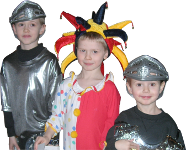Interactive Activities for Babies
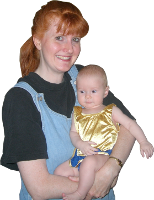 A baby's brain is truly amazing. During the first year of the baby's life, he is learning at such an astounding rate that it seems like a waste to not spend 5 minutes a day to expand his entire future potential. Glenn Doman from the Institute for the Achievement of Human Potential talks about how brain injured babies with only half their brain left in their head were given infant stimulation exercises. These babies ended up being able to read as one-year-old children. They were able to do math and other astonishing things, too. All of the babies in the study were way smarter than normal children. So if brain injured babies can achieve so much, what are the possibilities for normal children?
A baby's brain is truly amazing. During the first year of the baby's life, he is learning at such an astounding rate that it seems like a waste to not spend 5 minutes a day to expand his entire future potential. Glenn Doman from the Institute for the Achievement of Human Potential talks about how brain injured babies with only half their brain left in their head were given infant stimulation exercises. These babies ended up being able to read as one-year-old children. They were able to do math and other astonishing things, too. All of the babies in the study were way smarter than normal children. So if brain injured babies can achieve so much, what are the possibilities for normal children?
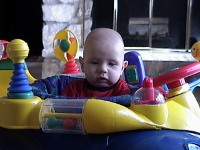 All of my own babies were able to read at age one and a half. I'm not joking. It was extremely easy and only took less than 60 seconds per day. (I also forgot for up to 3 months at a time, but I still got good results.) All I did was flash the letters of the alphabet with the sound. That's it. (I did not say the letter names, and all the vowels were short.) As soon as they could speak, they could sound out words. When Bryan was 18 months old, he sounded out b-o-x. Any words that he saw when we were out, he sounded out on his own. By age three, he could read the Bible (although he needed me for big words). At age 6, he was reading 3rd and 4th grade chapter books on his own, and by age 7, he could read on a high school level. My three other children are accomplishing these exact same results.
All of my own babies were able to read at age one and a half. I'm not joking. It was extremely easy and only took less than 60 seconds per day. (I also forgot for up to 3 months at a time, but I still got good results.) All I did was flash the letters of the alphabet with the sound. That's it. (I did not say the letter names, and all the vowels were short.) As soon as they could speak, they could sound out words. When Bryan was 18 months old, he sounded out b-o-x. Any words that he saw when we were out, he sounded out on his own. By age three, he could read the Bible (although he needed me for big words). At age 6, he was reading 3rd and 4th grade chapter books on his own, and by age 7, he could read on a high school level. My three other children are accomplishing these exact same results.
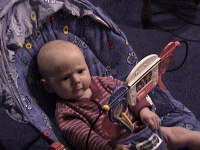
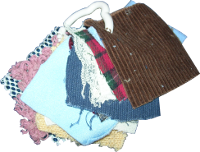 I do not recommend Glenn Doman's book Teaching Your Baby to Read, which promotes whole-word reading. I did this only with my second son, Stephen, and I saw no difference between him and my other kids, where I taught through just the letter sounds. I flashed a whole word to him, such as “nose,” and he would point to his nose. By the time he was 20 months old, he could silently read 200 words with no help from me. I would silently flash the word “pillow,” and he would run out of the room and come back with a pillow, for example. Or he would point to the correct animal on the wall, if I had flashed an animal word. But like I said, this was a lot more work, and all my other kids could read at one and a half without this extra work. All of these activities were fun for the baby. Nothing was ever forced in any way. There was joy.
I do not recommend Glenn Doman's book Teaching Your Baby to Read, which promotes whole-word reading. I did this only with my second son, Stephen, and I saw no difference between him and my other kids, where I taught through just the letter sounds. I flashed a whole word to him, such as “nose,” and he would point to his nose. By the time he was 20 months old, he could silently read 200 words with no help from me. I would silently flash the word “pillow,” and he would run out of the room and come back with a pillow, for example. Or he would point to the correct animal on the wall, if I had flashed an animal word. But like I said, this was a lot more work, and all my other kids could read at one and a half without this extra work. All of these activities were fun for the baby. Nothing was ever forced in any way. There was joy.
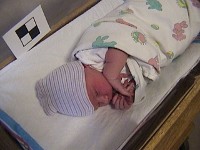 How else can you stimulate your baby's brain? In the book, How to Have a Smarter Baby, I found lots of simple activities that only took a few seconds to do. Once again, the baby giggles and loves it. Or the baby focuses and is very alert, and you can tell that he is thinking. The five senses are stimulated: sight, sound, touch, smell, and movement. (Movement takes the place of taste for tiny babies that only drink milk.)
How else can you stimulate your baby's brain? In the book, How to Have a Smarter Baby, I found lots of simple activities that only took a few seconds to do. Once again, the baby giggles and loves it. Or the baby focuses and is very alert, and you can tell that he is thinking. The five senses are stimulated: sight, sound, touch, smell, and movement. (Movement takes the place of taste for tiny babies that only drink milk.)
For sight: focus on a black and white design. It helps with tracking. (When one of my babies was fussing one night, nothing helped his tummy ache until I showed him a black and white design. He abruptly stopped crying and focused for quite a while on the design.) For letters and numbers, I had the baby on my lap, and I took his hand and traced the letter or number while saying the sound or number. I only did this maybe a few times a month.
For sound: rattle to the right, then to the left. Narrate sounds around the house. “Microwave,” you say as you're heating up your coffee. “Faucet,” you say as you wash off the splashed coffee from your hand. 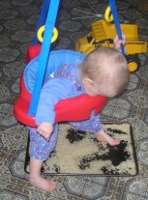 “Door,” you say as the door creaks back and forth. You can also say nursery rhymes – the repeating sounds are comforting.
“Door,” you say as the door creaks back and forth. You can also say nursery rhymes – the repeating sounds are comforting.
For touch: different textures should be made available. To make it easier for me, I cut squares of different textures of fabrics, hole punched them, and put a ring through them.
For smell: foods, spices, and flowers are good. Stay away from essential oils – their smell is too strong.
For movement: roll them to the right and left while saying “right” or “left.” (They love this!) Do the same with up/down. Have an item hidden under a cup for them to lift. Pull a blanket to get an item on the far end of the blanket. Help them crawl forward. Play interactive games like pat-a-cake, head-shoulders-knees-and-toes, open them/shut them, etc. The Wee Sing for Baby music has more. When my daughter was a baby, my three-year-old son made up his own interactive game with her, which always made her giggle because she knew that it was nonsense. So you can make up your own.
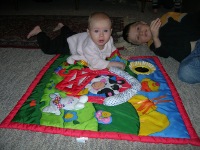 Activity mats to crinkle and pull, baby buggies with many gadgets, and a buzz chair with toys to look at are good ideas for when you need to put the baby down to cook dinner or spend time with your other children. Push toys are good for developing leg muscles for walking; just make sure you don't have an open stairwell nearby. I had an 8-month-old baby walking (on his own) because of a push toy, although it can sometimes go too fast. Jumpers are good for leg muscles, too. I put my jumpers near a mirror and a number chart so that they wouldn't get bored. I sometimes put a tray of rice or flour under their bare feet so they could swish it around.
Activity mats to crinkle and pull, baby buggies with many gadgets, and a buzz chair with toys to look at are good ideas for when you need to put the baby down to cook dinner or spend time with your other children. Push toys are good for developing leg muscles for walking; just make sure you don't have an open stairwell nearby. I had an 8-month-old baby walking (on his own) because of a push toy, although it can sometimes go too fast. Jumpers are good for leg muscles, too. I put my jumpers near a mirror and a number chart so that they wouldn't get bored. I sometimes put a tray of rice or flour under their bare feet so they could swish it around.
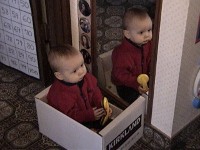 Even if you don't have any money for all of these gadgets, you can prop your child in a box by the mirror and give him a random item from your house that is not a choking hazard. He'll have fun for longer than you might think. And always try to have a bedtime routine so that they can teach themselves to fall asleep. My favorite lullaby CD was “Sleep Sound in Jesus” by Michael Card. Night, night!
Even if you don't have any money for all of these gadgets, you can prop your child in a box by the mirror and give him a random item from your house that is not a choking hazard. He'll have fun for longer than you might think. And always try to have a bedtime routine so that they can teach themselves to fall asleep. My favorite lullaby CD was “Sleep Sound in Jesus” by Michael Card. Night, night!
For more information about Early Childhood Education, click here.







